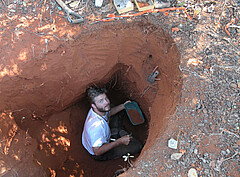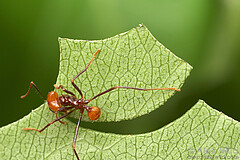Detail view
"Science" publication: Ants have been farming – for 66 million years [17.10.24]
Cultivation of fungi by ants and the associated coevolution began with an asteroid hit / University of Hohenheim: Newly discovered species are beneficial to species conservation
Humans are not the only ones who farm – ants have been practicing this art for much longer. They cultivate fungi. For more than 66 million years, as demonstrated by researchers with the support of the University of Hohenheim in Stuttgart. This was made possible by gene sequencing, from which an evolutionary tree of the fungi could be generated. By combining this with the ants' evolutionary tree, the researchers were able to provide evidence of millions of years of coevolution in which the species influenced each other's evolution. The fact that the researchers were also able to describe new species benefits the protection of biodiversity. The findings have now been published in the scientific journal Science. DOI: www.science.org/doi/10.1126/science.adn7179
Prof. Dr. Christian Rabeling needs two things – patience and endurance. In the tropical heat, he carefully follows tiny tunnels up to two meters long in the earth, which sometimes fan out like fir trees. He has to be wary of some master builders of these works of art: leafcutter ants can react quite aggressively to disturbances. Smaller ant species, on the other hand, are very shy and retreat from him.
It can take up to three days for the researcher from the University of Hohenheim to find what he is looking for: a kind of nest the size of a golf ball at the end of a corridor. Agriculture has been practiced in these nests for around 66 million years, according to the researchers' latest findings.
"The ants specifically cultivate fungi as a food source and provide leaves as the substrate," explained the evolutionary biologist. Over 250 ant species are now specialists in the cultivation of fungi, and the fungi, in turn, have adapted closely to their hosts over the course of evolution. "Some form structures that only occur in cultivation by ants. And they cannot be cultivated outside the ants' nest – an indication of a genuine coevolutionary relationship in which both partners influence each other and evolve together."
DNA sequence analyses provide insight into relationships
The phenomenon itself came to light about 150 years ago. Naturalist Fritz Müller described his observations of fungus-growing ants in Brazil in his letters to his colleague Charles Darwin, whereupon Darwin sent the correspondence to the scientific journal Nature for publication in 1874. However, for a long time it was not possible to distinguish the different species of fungi from each other or to reconstruct their phylogeny. It is only since the 1990s that molecular biological studies have made it possible to draw any conclusions.
Since then, researchers have been able to use DNA sequence analyses to establish the relationships between different species. The similarity of genes provides information about the relationship and the course of evolution. "Today, we use modern high-throughput methods that have revolutionized evolutionary biology," explained Prof. Dr. Rabeling.
The researchers use so-called highly conserved genes that have hardly changed over long periods of time and across species boundaries. They are found in many organisms and serve as anchor points for analyzing thousands of gene segments from small samples. Ultimately, entire evolutionary trees can be created from this.
Coevolution of fungi and ants – for 66 million years
"We already had evolutionary trees for ants, but now we have also succeeded in drawing up evolutionary trees for fungi," said a delighted Prof. Dr. Rabeling. He and his team combined the new evolutionary tree for 475 species of fungi with a tree for 276 species of ants. This comparison revealed that a common ancestor lived among both the fungus-growing ants and the fungi around 66 million years ago – shortly after an asteroid hit in the area of what is now Mexico's Yucatán Peninsula, which triggered the extinction of the dinosaurs.
This moment marks an important phase in the history of the Earth, and not just for large reptiles. Cooling and darkness also led to the mass extinction of many plant species, and this secured fungi an evolutionary advantage. "This could have been a key factor in ants increasingly specializing in fungi."
Newly described species serve to protect biodiversity
By taking a look at evolutionary history, the researchers have discovered and described numerous new species and genera in their work. This will benefit biodiversity in the future. The Competence Centre for Biodiversity and Integrative Taxonomy (KomBioTa), of which Prof. Dr. Rabeling's department is a core element, has taken up this topic.
"Species description is the first step towards protecting biodiversity," said the expert. "Because we can only protect species that we are familiar with. And the more we know about them, where they occur and how they live, the better we can derive measures to protect them."
SCIENCE publication
Ted R. Schultz et al., The coevolution of fungus-ant agriculture. Science 386, 105-110 (2024). https://www.science.org/doi/10.1126/science.adn7179
BACKGROUND: Competence Center Biodiversity and Integrative Taxonomy (KomBioTa)
The extinction of species and, more particularly, the decline of insects, is one of the major challenges of the 21st century. The loss of diversity affects plants, animals, fungi and microorganisms, the absence of which jeopardizes the function of ecosystems and, by extension, important services for humans too, such as plant pollination and even fundamental ecosystem services such as air and water purification. To meet these challenges, KomBioTa was established in 2020 at the University of Hohenheim and the Natural History Museum Stuttgart with state backing. It brings together numerous working groups at both institutions for joint research and teaching, including the Department of Integrative Taxonomy of Insects headed by Prof. Dr. Christian Rabeling. The state of Baden-Württemberg provides funding for KomBioTa totaling around EUR 1 million per year as part of the state initiative "Integrative Taxonomy". More information
Text: Elsner
Contact for press:
Prof. Dr. Christian Rabeling, University of Hohenheim, Department of Integrative Taxonomy of Insects
T +49 711 459 22447, E christian.rabeling@uni-hohenheim.de
Back to








